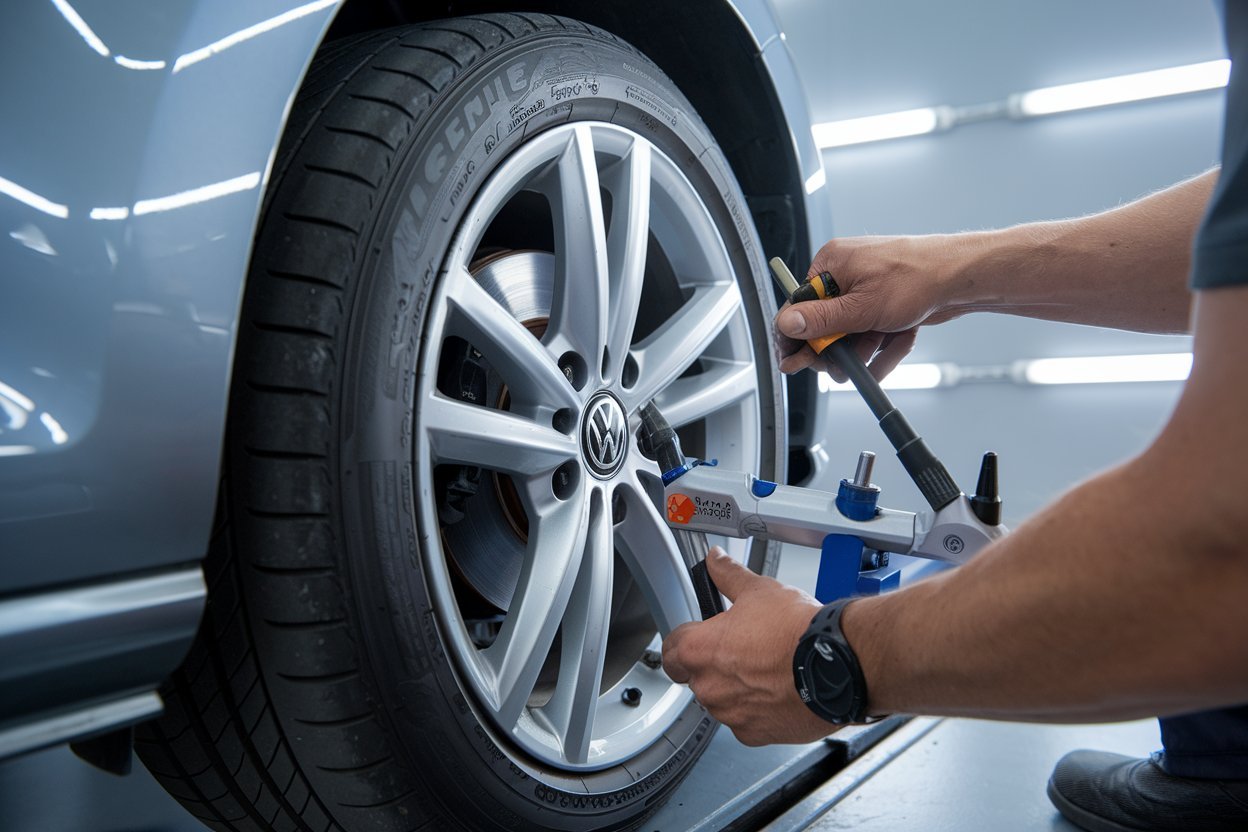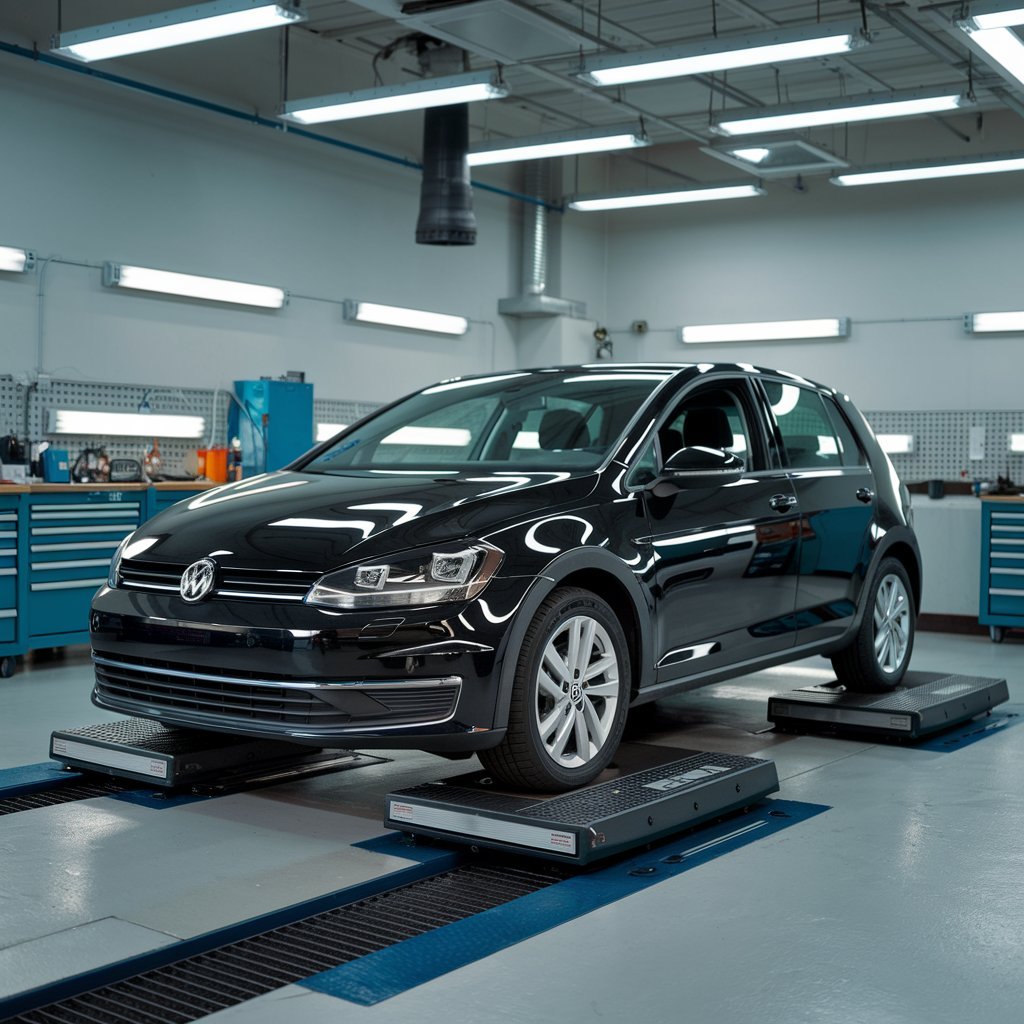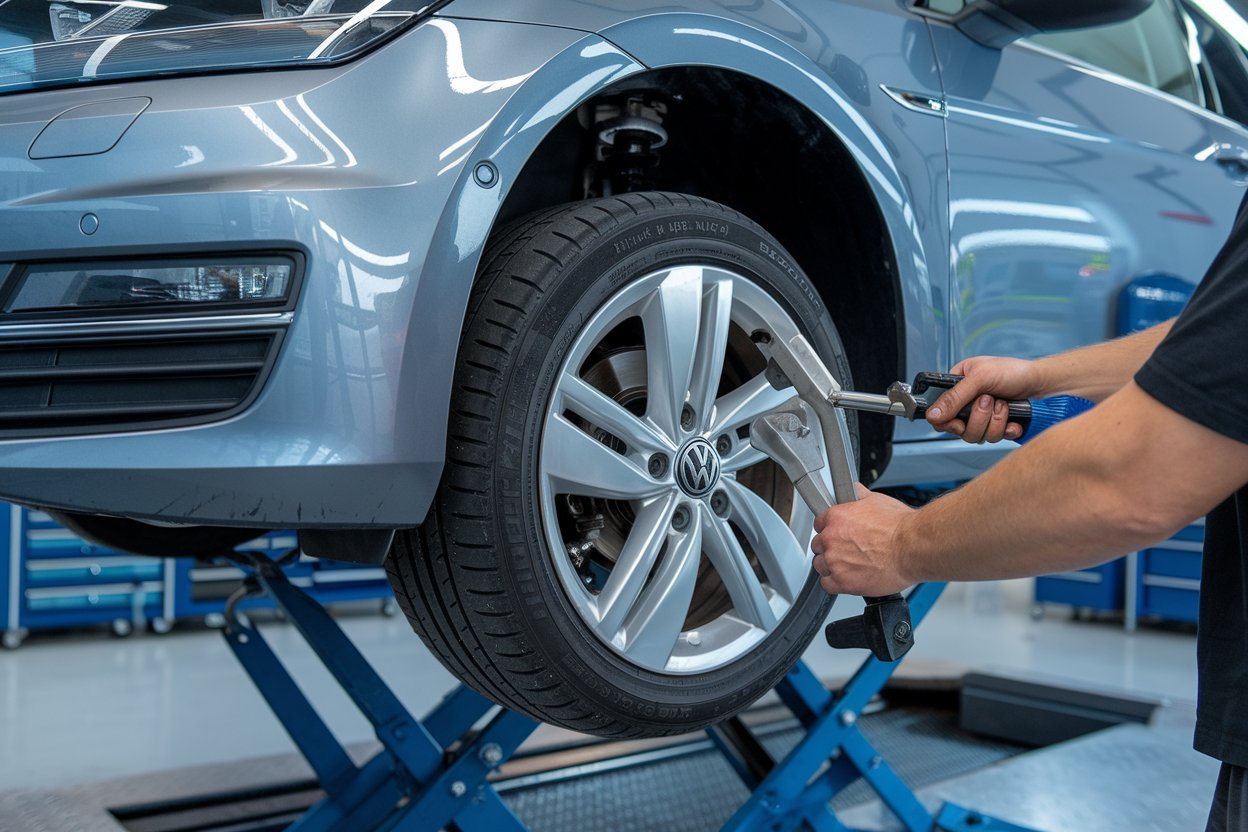Is your Volkswagen Golf pulling to one side or showing uneven tire wear? It might be time for a professional wheel alignment. At our Volkswagen Golf wheel alignment service in Dubai, we specialize in ensuring your vehicle handles like new. With state-of-the-art equipment and certified technicians, we offer precise alignment adjustments for optimal tire wear, improved fuel efficiency, and enhanced driving safety. Did you know that misalignment can reduce tire life by up to 25%? Don’t wait until you see major wear – our affordable alignment services come with a 17% discount for a limited time! Book today and experience smooth, controlled driving on every trip.

Wheel alignment is the process of adjusting the angles of a vehicle’s wheels to the manufacturer’s specifications. This includes three key components: toe, camber, and caster. Proper alignment ensures that all four wheels are parallel to each other and perpendicular to the ground. It helps in distributing weight evenly across the tires, reducing uneven tire wear and improving overall vehicle handling. When your wheels are aligned correctly, your car moves smoothly, and you experience better control, stability, and safety on the road.
Misalignment can lead to a range of issues, including poor steering response, increased fuel consumption, and faster tire wear. Over time, these problems can lead to costly repairs, such as replacing tires or damaged suspension parts. Regular wheel alignment ensures your vehicle’s performance is optimized, enhancing fuel efficiency and extending the life of your tires. It’s an essential maintenance task that helps maintain the overall driving experience and safety of your Volkswagen Golf.
Wheel alignment involves adjusting three main angles that affect how your vehicle drives and wears tires: toe, camber, and caster. Each of these components plays a vital role in ensuring your vehicle handles properly, performs at its best, and remains safe on the road. Understanding these key components is crucial for maintaining the health of your Volkswagen Golf and avoiding costly repairs. A proper alignment of these angles helps improve steering response, tire longevity, and overall vehicle stability, ensuring a smoother and more efficient driving experience. Let’s break down each component to understand its impact on your car.
This is the angle of the tires relative to the vehicle. Toe-in means the tires point inward. Toe-out means they point outward. Misalignment causes uneven tire wear and poor handling. Correct toe alignment ensures smooth driving and better tire life.
Camber is the tilt of the tire when viewed from the front. Positive camber tilts the top outward. Negative camber tilts the top inward. Misalignment can cause uneven tire wear and affect stability. Proper camber helps keep the car stable and tires even.
Caster is the angle of the steering axis when viewed from the side. Positive caster improves steering stability. Misalignment leads to poor steering response. Proper caster alignment makes steering easier and more controlled.
Wheel misalignment can occur due to various factors, all of which can negatively impact the performance and longevity of your vehicle. Properly identifying the causes of misalignment helps prevent unnecessary wear and tear on your Volkswagen Golf and ensures smoother driving. Here are the most common causes of misalignment:
Hitting potholes, curbs, or debris can disrupt the alignment of your wheels. Even small impacts can knock the suspension components out of position, leading to poor handling and uneven tire wear. Frequent exposure to rough roads increases the risk of misalignment over time.
Over time, suspension components such as ball joints, tie rods, and control arm bushings can wear out. When these parts become loose or damaged, they can cause the alignment to shift. Regular suspension maintenance is crucial for ensuring that alignment remains intact and that the vehicle stays stable.
Modifying your vehicle, such as adjusting the suspension height or changing the wheel size, can throw off the alignment. These changes often require recalibration to avoid improper tire wear and poor handling. It’s important to have any modifications checked by a professional to ensure the alignment is adjusted correctly.
Even minor accidents or fender benders can affect the alignment of your wheels. Impact to the frame or suspension system can shift the alignment angles, leading to steering instability and uneven tire wear. If your vehicle has been in an accident, it's essential to have the alignment inspected.

If you’re driving your Volkswagen Golf and notice any of the following issues, it may indicate that your wheels are misaligned. Identifying these specific signs early can help prevent unnecessary tire wear and other damage to your vehicle. Here are some specific signs that your Volkswagen Golf needs wheel alignment:
These signs suggest that your Volkswagen Golf may need immediate attention from a professional for wheel alignment. Proper alignment helps maintain vehicle stability and ensures a safer, smoother driving experience.
We follow a detailed, 6-step wheel alignment process to ensure your VW Golf R performs at its best. Our expert technicians use state-of-the-art equipment to align the wheels and provide a precise adjustment. Here’s our step-by-step approach for VW Golf Wheel Alignment:
Before beginning the alignment, we thoroughly inspect the suspension and steering system of your VW Golf R. We check for any worn or damaged parts, such as tie rods, ball joints, or control arms. This ensures that all components are in good condition before proceeding with the alignment.
Proper tire condition is critical for accurate alignment. We examine the tire tread for signs of uneven wear and ensure the tire pressure is correct. If the tires are underinflated or overinflated, it can affect alignment results and tire wear, so we make sure your VW Golf R tires are ready for the alignment procedure.
Using high-precision alignment equipment, we measure the three main angles: toe, camber and caster. These measurements ensure that your wheels are correctly positioned to reduce tire wear and improve handling. Any discrepancies are identified and recorded before adjustments are made.
Once measurements are taken, we adjust the toe, camber, and caster angles to manufacturer specifications. This ensures that the wheels are aligned correctly for optimal performance and tire longevity. Adjustments are made with precision, taking into account the specific needs of your VW Golf.
After the adjustments are made, we take your VW Golf R for a test drive to evaluate the steering response, handling, and alignment. We monitor for any issues such as pulling to one side or vibrations in the steering wheel, ensuring everything functions as expected.
After the test drive, we perform a final inspection to ensure the alignment is correct and that all adjustments are within the specified range. We provide a detailed alignment report, highlighting the adjustments made and the current condition of your vehicle’s alignment.
Advanced Driver-Assistance Systems (ADAS) are designed to enhance safety and driving convenience, but their functionality heavily depends on accurate wheel alignment. Misaligned wheels can interfere with these systems, affecting their accuracy and reliability. Here are some key points on how ADAS and wheel alignment are connected:
Ensuring your VW Golf is properly aligned is crucial, especially if it’s equipped with advanced systems like ADAS. Not only does wheel alignment improve overall vehicle handling, but it also ensures that these advanced safety features work as intended for a safer driving experience.
Ensuring your VW Golf has proper wheel alignment is essential for optimal performance and tire longevity. In Dubai, the cost for wheel alignment services typically ranges from AED 80 to AED 300, depending on the service provider and the specific requirements of your vehicle.
Please note that these are general estimates. For an exact quote tailored to your VW Golf, we recommend contacting us directly. Our team will provide a detailed assessment and pricing based on your vehicle’s specific needs.

Trust our team of Expert Volkswagen Mechanics at our Volkswagen Service Center in Dubai for all your Volkswagen Repair and service needs.
Our Top-Notch Volkswagen Service Center in Dubai have the advanced diagnostic tools and Volkswagen experts to accurately identify and resolve any issues with your Volkswagen.
With over 1200+ Volkswagen repaired, our Volkswagen Service Center in Dubai is the trusted Garage for comprehensive and expert Volkswagen Repair services.
Most of the vehicles get damaged just because of maintenance neglect you take
Book a Call Back Now
Proper wheel alignment is essential for maintaining the performance, safety, and longevity of your VW Golf. Don’t wait for signs of misalignment to affect your vehicle’s handling and tire life. Schedule your wheel alignment service today and ensure your vehicle runs smoothly, safely, and efficiently. Whether you’re experiencing uneven tire wear, steering instability, or simply want to keep your VW Golf in optimal condition, our expert technicians are here to help. Contact us now for a fast and accurate alignment service and get your Volkswagen Golf back on the road in perfect alignment.
The recommended frequency for wheel alignment checks is every 12,000 miles (approximately 19,000 kilometers) or at least once a year. However, if you notice signs like uneven tire wear, your VW Golf pulling to one side, or steering wheel misalignment, you should have the alignment checked sooner. Regular alignment services help maintain optimal vehicle performance, prevent tire damage, and enhance fuel efficiency.
Ignoring misalignment in your VW Golf can lead to several issues, including uneven tire wear, which can shorten the lifespan of your tires. Additionally, misalignment affects your steering response, causing the vehicle to pull to one side or making the steering feel loose. Over time, this can put extra strain on other suspension components, leading to increased repair costs. Proper alignment ensures that all wheels maintain optimal contact with the road, improving handling, stability, and safety.
Yes, wheel alignment plays a significant role in fuel efficiency. Misaligned wheels create additional rolling resistance, which means your VW Golf requires more power to maintain speed. This increased resistance can reduce fuel efficiency, causing your vehicle to consume more fuel than necessary. Keeping your wheels properly aligned can improve your mileage and save on fuel costs in the long run.
Yes, if your VW Golf pulls to one side, it’s often due to misalignment. Whether the issue lies in the toe, camber, or caster angles, a professional alignment can correct the angles and stop your vehicle from pulling. However, if the pulling is caused by other issues like tire pressure problems or suspension damage, those will need to be addressed first.
Absolutely. When you replace components of your VW Golf’s suspension, such as control arms, tie rods, or ball joints, the suspension geometry changes. This makes it crucial to perform a wheel alignment to ensure that the new parts are set correctly and the vehicle handles properly. Not aligning after suspension repairs can lead to poor handling, tire wear, and other driving issues.
Yes, if your VW Golf is equipped with Advanced Driver-Assistance Systems (ADAS), proper wheel alignment is crucial for the proper functioning of safety features like Lane Assist, Adaptive Cruise Control (ACC), and Automatic Emergency Braking (AEB). Misalignment can cause these systems to become less accurate, resulting in false alerts or even failure to activate when needed. Ensuring the alignment is correct guarantees that these features work as designed, enhancing your driving safety.
Signs that your VW Golf might need an alignment include uneven tire wear, the steering wheel being off-center while driving straight, your car pulling to one side, or vibrations in the steering wheel. If you experience any of these issues, it’s important to have your alignment checked by a professional. Misalignment can affect both vehicle handling and tire life, so addressing these problems early can prevent further damage.
“Talk to a Volkswagen Expert Now by booking a call, and get personalised solutions for your Volkswagen unique needs and requirements.”
+971564646081
